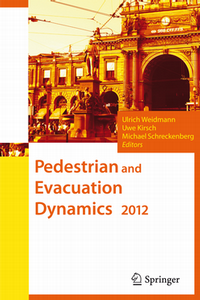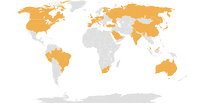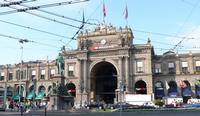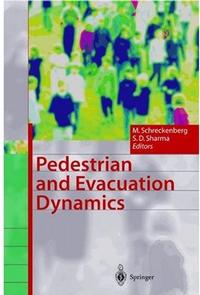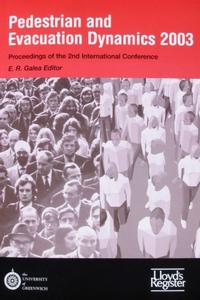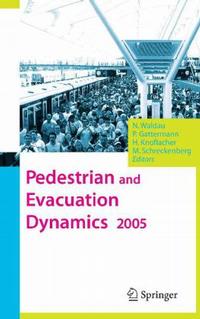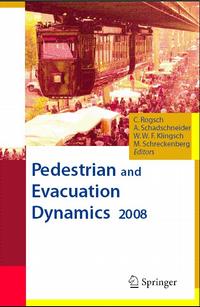|
|||||||||||
Conference

Date
6-8 June 2012
News
- Book Preview: Transporttechnik der Fussgänger
- Follow us on Twitter
Previous Conferences
- PED 2010 - Gaithersburg
- PED 2008 - Wuppertal
- PED 2005 - Vienna
- PED 2003 - Greenwich
- PED 2001 - Duisburg
Download
Programme 2012 (PDF 0.2MB)
Programme 2012 (PNG 0.9MB)
Welcome to Zurich

6th International Conference on Pedestrian and Evacuation Dynamics - PED 2012
Next conference
Publication
Weidmann, U., U. Kirsch and M. Schreckenberg (2014) Pedestrian and Evacuation Dynamics 2012, Springer, Heidelberg.
| Information | ||
| Programme | ||
|
Information for authors |
||
|
Picture gallery |
||
|
Download |
||
About the Conference
The continuously growing number of events with hundreds to thousands of visitors, the increasing complexity of the built environment - faced with on-going growth of pedestrian movement - and the need to be prepared to handle more and more complex incident scenarios of fire, terrorism, and large-scale community disasters give reason to focus on the understanding of the behaviour of humans as pedestrians and also evacuation dynamics. The aim is to provide answers for policy makers, planners, designers, and emergency management to solve real world problems in this rapidly developing field.
The Pedestrian and Evacuation Dynamics (PED) conference will address both pedestrian and evacuation dynamics. A better understanding of human behaviour is the key to planning and management of pedestrian flows. A limited view from only one perspective or from one planning discipline respectively seems not to be promising for resolving the problems due to the advancing level of complexity. Furthermore a link is needed from research to practice to become aware of problems on the one hand and methods and tools on the other hand.
The PED conference is the place to present research results, practical experiences, real world problems and to communicate and discuss between/beyond disciplines.
PED 2012 will be the sixth edition of this successful conference series that started in Duisburg, Germany in 2001. Previous conferences had also been held in Greenwich, UK (2003), Vienna, Austria (2005), Wuppertal, Germany (2008) and Gaithersburg, USA (2010).
| Confirmed keynote speakers | ||
| Marjolein de Jong | Universiteit Hasselt | "The characteristics and needs of pedestrians with mobility impairments - How to move around comfortably and safely with a reduced ability to walk, see, hear, feel or process information" |
| Uwe Hanebeck | Karlsruhe Institute of Technology | "Multimodal Extended Range Telepresence in Pedestrian Simulation" |
| Paul I. Weinmann | ICTS Europe, Amsterdam | "Behavior Assessment of Individuals in Crowds - a View from the Perspective of Aviation and Airport Security" |
| Mehdi Moussaïd | Max Planck Institute, Berlin | "The modeling of human crowd behavior: Where physics meets cognitive science" |
| Peter Jenkins | Building Design Partnership, Manchester | "Shaping the space: turning function into inspiration" |
| Andrew Hutton | Network Rail, London | "London Bridge – the significant role ped modelling plays in designing the new station and how to deliver it" |
| Chris Kemp | Buckinghamshire New University | "New developments in crowd management, safety and dynamics - Managing risk for safer crowded places" |
| Evening presentation / Press event | ||
| Thomas Brudermann | University of Graz | "Mass psychology revisited - Insights from Social Psychology, Neuroscience and Simulation" |
Conference topics include
- Behavioral aspects of pedestrian movements
- Data collection techniques
- Disasters: recent case studies
- Disasters: theories, analysis, conclusions
- Evacuation and pedestrian data collection from experiments and real events
- Large-scale and transport modeling
- Model development and modeling methods
- Model validation/calibration
- Passenger transport logistics
- Population development worldwide
- Public transport transfer terminals
- Regional evacuation
- ... and related research areas
Papers and posters presenting recent work on major practical planning projects are also welcome. The projects should involve the latest pedestrian research findings.
Conference delegates / target audience include
- Operators / administrators of public transport facilities
- Researchers of human behaviour
- Transportation engineers
- Architects
- Social scientists
- Rail operators
- Fire safety engineers
- Robotics experts
- Simulation software developers
- Computer scientists
- Airport operators
- Safety and security planners / personnel
- Manufacturers of mechanical people movers, elevators, escalators, etc.
- City planners
- Rolling stock manufacturers
- Members of transport authorities
- ...
Programme
| 6 June 2012 | |||
|
9:00 |
U. Walter |
Opening Presentation: The missing link to practice |
|
|
9:30 |
P. Jenkins |
Shaping the space: turning function into inspiration |
|
|
10:00 |
Parallel sessions | ||
|
A1 |
T. Kretz |
The effect of integrating travel time |
|
|
A2 |
V. Reuter, B.S. Bergner, G. Köster, M. Seitz, F. Treml, D. Hartmann |
On Modeling Groups in Crowds: Empirical Evidence and Simulation Results Including Large Groups |
|
|
A3 |
G. Köster, F. Treml, M. Seitz, W. Klein |
Validation of crowd models including social groups |
|
|
B1 |
M. D' Orazio, G. Bernardini |
An experimental study on the correlation between "attachment to belongings" "pre-movement" time |
|
|
B2 |
L. Ulriksen, A.S. Dederichs |
Evacuation of day care centres for children 0-6 years: Simulations using Simulex |
|
|
B3 |
M. Kinsey, E. Galea, P. Lawrence |
Modelling Evacuation using Escalators: a London Underground Dataset |
|
|
C1 |
C. Appert-Rolland |
Experimental Study of Pedestrian Dynamics |
|
|
C2 |
L. Bourgois, J-M. Auberlet |
Pedestrian Agent Based Model Suited to Heterogeneous Interactions Overseen by Perception |
|
|
C3 |
J. Dijkstra |
Measuring Individual's Egress Preference in Wayfinding Through Virtual Navigation Experiments |
|
|
11:40 |
Parallel sessions | ||
|
A5 |
H. Mayer |
Influence of Emissions on Pedestrian Evacuation |
|
|
A6 |
C. Rogsch |
RiMEA: A Way to Define A Standard For Evacuation Calculations |
|
|
B4 |
M. Nasir |
Fuzzy Prediction of Pedestrian Steering Behavior with Local Environmental Effects |
|
|
B5 |
E. Kirik, A. Malyshev, E. Popel |
Fundamental diagram as a model input: direct movement equation of pedestrian dynamics |
|
|
B6 |
F. Zanlungo, Y. Chigodo, T. Ikeda, T. Kanda |
Experimental study and modelling of pedestrian space occupation and motion pattern in a real world environment |
|
|
C4 |
L. Künzer |
Psychological Aspects of German Signal Words in Evacuation Warnings |
|
|
C5 |
M. Okaya, T. Takahashi |
Effect of guidance information and human relations among agents on crowd evacuation behavior |
|
|
14:30 |
M. de Jong |
The characteristics and needs of pedestrians with mobility impairments |
|
|
15:00 |
Parallel sessions | ||
|
A7 |
M. Schulz |
Stochastic transition model for pedestrian dynamics |
|
|
A8 |
T. Fujiyama |
The Effects of the Design Factors of the Train-Platform Interface on Pedestrian Movements |
|
|
A9 |
D. Bauer, J. Gantner, |
Including Route Choice Models into Pedestrian Movement Simulation Models |
|
|
B7 |
D. Hartmann, J. Mille, A. Pfaffinger, C. Royer |
Dynamic Medium Scale Navigation Using Dynamic Floor Fields |
|
|
B8 |
P. Townsend |
Pedestrian Gap Acceptance in Micro-Simulation Modelling |
|
|
B9 |
F. Huth, G. Bärwolff, H. Schwandt |
A Macroscopic Multiple Species Pedestrian Flow Model Based on Heuristics Implemented with Finite Volumes |
|
|
C7 |
M. Chraibi |
A simplified force model and enhancedsteering for a quantitative description ofpedestrian dynamics |
|
|
C8 |
M. Campanella, S. Hoogendoorn, W. Daamen |
Quantitative and qualitative validation forgeneral use of pedestrian models |
|
|
C9 |
T. Korhonen, K. Naveesh Reddy, A.K. Babbar |
FDS+Evac Model Validation for Seated Row Arrangements: Aircraft and Cinema Theatre |
|
|
16:40 |
U.D. Hanebeck |
Multimodal Extended Range Telepresence in Pedestrian Simulation |
|
|
17:10 |
Parallel sessions | ||
|
A10 |
M. Plaue |
On measuring pedestrian density and flowfields in dense as well as sparse crowds |
|
|
A11 |
S. Bonneaud |
A Behavioral Dynamics Approach to Modeling Realistic Pedestrian Behavior |
|
|
A12 |
S. Burghardt |
Fundamental Diagram of Stairs: Critcal Review and Topographical Measurements |
|
|
B10 |
K. Rio, W.H. Warren |
A data-driven model of pedestrian following and emergent crowd behavior |
|
|
B11 |
C. Rudloff, T. Matyus, S. Seer |
Comparison of different Calibration Techniques on Simulated Data |
|
|
B12 |
M. Schultz, L. Rößger, H. Fricke, B. Schlag |
Group dynamic behavior and psychometric profiles as substantial driver for pedestrian dynamics |
|
|
20:00 |
T. Brudermann |
Mass Psychology Revisited: Insights from Social Psychology, Neuroscience and Simulation |
|
| 7 June 2012 | |||
|
9:00 |
P.I. Weinmann |
Behavior assessment of individuals in crowds: A perspective of civil aviation security |
|
|
9:30 |
Parallel sessions | ||
|
A13 |
R. Jobanputra |
The development and calibration of an agent- based micro-simulation model for vehicle- pedestrian interaction |
|
|
A14 |
H. Aydt, M.H. Lees, S.J. Turner, W. Cai |
Toward simulation-based egress optimization in smart buildings using symbiotic simulation |
|
|
A15 |
C. Dobler |
Integration of a multi-modal simulation module into a framework for large-scale transport systems simulation |
|
| B13 |
H. Schrom-Feiertag, T. Matyus, M. Brunnhuber |
Simulation of Handicapped People Finding their Way through Transport Infrastructures |
|
|
B15 |
T. Osaragi, T. Morisawa, T. Oki |
Simulation
Model of Evacuation Behavior Following a Large-scale Earthquake that
Takes into Account Various Attributes of Residents and Transient
Occupants |
|
|
C13 |
J. Pettré |
Velocity-based models for crowd simulation |
|
| C14 |
D.C. Duives, W. Daamen, S.P. Hoogendoorn |
Trajectory analysis of crowd movements at a Dutch Music Festival |
|
|
C15 |
G. Bärwolff, M. Chen, F. Huth, G. Lämmel, M. Plaue, H. Schwandt |
Methods for Modeling and Simulation of Multi-Destination Pedestrian Crowds |
|
|
14:00 |
M. Moussaïd |
The Modelling of Human Crowd Behaviour: Where physics and cognitive science meet |
|
|
14:30 |
Parallel sessions | ||
|
A16 |
A.U. Kemloh |
Empirical Study and Modelling of Pedestrians' Route Choice in a Complex Facility |
|
|
A17 |
P. Tofilo, M. Cisek, K. Lacki |
The Study on the Effects of the Counter-Flow on the Evacuation of People from Tall Buildings |
|
|
A18 |
R. Zinke, G. Hofinger, L. Künzer |
Psychological aspects of human dynamics in underground evacuation: Field experiments |
|
|
B16 |
G. Lämmel, M. Plaue |
Getting out of the way: collision avoiding pedestrian models |
|
|
B17 |
I. Martinez |
Methodology for pedestrian simulation with complex/random routes in public spaces |
|
|
B18 |
L. Adiaviakoye |
Collection of data stemming from the fine trajectory of the pedestrians |
|
|
16:10 |
C. Kemp |
Managing crowded spaces |
|
|
16:40 |
D. Manocha |
Velocity-space approaches for multi-agent and crowd simulation |
|
|
16:40 |
M. Shah |
Automatic Detection and Tracking of Pedestrains |
|
| 8 June 2012 | |||
|
9:00 |
A. Hutton |
London Bridge Station, The Role of Ped Modelling: Pedestrian Modelling and Design Development |
|
|
9:30 |
Parallel sessions | ||
|
A19 |
H. Klüpfel |
Decision Support (PedGo Guardian) |
|
|
A20 |
Q. Li, Z. Fang, Q. Li |
Ant colony based evacuation route optimization model for mixed pedestrian-vehicle flows |
|
|
A21 |
K.L. Marsh, C.T. Wilkie, P.B. Luh, Z. Zhang, T. Gifford, N. Olderman |
Crowd Guidance in Building Emergencies: Using Virtual Reality Experiments to Confirm Macroscopic Mathematical Modeling of Psychological Variables |
|
|
B20 |
S. Curtis, D. Manocha |
Pedestrian reasoning using geometric reasoning in velocity space |
|
|
B21 |
D. Yanagisawaa, A. Tomoedab, K. Nishinaric |
Influence of Rhythm and Velocity Variance on Pedestrian Flow |
|
|
C19 |
T. Chen, L. Pan, G. Zhang |
Study of human behavior before evacuation |
|
|
C20 |
L. Feng, C. Miller-Hooks |
Modeling pedestrian route choice during large public gatherings |
|
|
C21 |
A.S. Mordvintsev, V.V. Krzhizhanovskaya, M.H. Lees, P.M.A. Sloot |
Simulation of City Evacuation Coupled to Flood Dynamics |
|
|
12:00 |
U. Weidmann |
PED 2012: Impressions and Thanks |
|
Posters
| 6-8 June 2012 | |||
|
P2 |
C. Appert-Rolland, P. Degond, S. Motsch |
A macroscopic model for bidirectional pedestrian flow |
|
|
P7 |
D. Fukuda, T. Seo, K. Yamada, H. Yaginuma, N. Matsuyama |
An econometric based pedestrian walking behaviour model implicitly considering strategic or tactical decisions |
|
|
P8 |
V. Viswanathan, M. Lees |
An information processing based model of pre-evacuation behavior for agent based egress simulation |
|
|
P10 |
M.L. Federici, A. Gorrini, L. Manenti, G. Vizzari |
An innovative scenario for pedestrian data collection: The observation of an admission test at the University of Milano-Bicocca |
|
|
P13 |
T. Rinne, T. Korhonen, P. Grönberg |
Bottlenecks in Evacuation Design: An Experimental Study |
|
|
P15 |
B. Forell, H. Klüpfel, S. Schelter, V. Schneider |
Comparison of Evacuation Simulation Models: Simulex, Aseri, buildingExodus and PedGo applied to an Auditorium |
|
|
P19 |
G. Wurzer |
Early-stage egress simulation for process-driven buildings |
|
|
P22 |
R.L. Galiza, L. Ferreira, P. Charles |
Estimating PCE-Type Factors for Heterogeneous Pedestrian Traffic Using Simulation |
|
|
P25 |
S. Hebben |
Evacuation Analyses for Venues: Systematic Approach and Comparison to Evacuation Trials |
|
|
P26 |
S. Göttlich, S. Kühn, J.P. Ohst, S. Ruzika |
Evacuation dynamics influenced by spreading hazardous material |
|
|
P27 |
P. Gessler |
Evacuation Exercises in a TV Studio: Comparison to Simulation Results |
|
|
P32 |
B. Krausz, C. Bauckhage |
Integrating lateral swaying of pedestrians into simulations |
|
|
P35 |
D. Durst, G. Lämmel, H. Klüpfel |
Large-scale Multi-Modal Evacuation Analysis with an Application to Hamburg |
|
|
P40 |
K.V. Kostas, A.-A.I. Ginnis, C.G. Politis, P.D. Kaklis |
Motions effect for crowd modeling aboard ships |
|
|
P49 |
A. Danalet, M. Bierlaire, B. Farooq |
Estimating Pedestrian Destinations using Traces from WiFi Infrastructures |
|
|
P52 |
C. Jaisung, K. Sangyoup, K. Sunggyu, J. Minsu, K. Yongseok, K. Jinkug |
Pedestrian Conflicts, Pedestrian Comfort Levels, and Current Pedestrian Levels of Service |
|
|
P55 |
B.R. Werberich, C.O. Pretto, H.B.B. Cybis |
Simulation Model for Vehicle and Pedestrian Interaction Considering Road Crossing Activities |
|
|
P58 |
H. Klüpfel |
Large Events: Specific Requirements for Evacuation Analysis |
|
|
P61 |
H. Klüpfel |
The Loveparade Disaster: Causes and Consequences |
|
|
P63 |
M. Boltes, A. Seyfried |
Tracking People in Crowded Scenes: Markerless Extraction of Trajectories with Stereo Recordings |
|
|
P66 |
A. Kneidl, D. Hartmann, A. Borrmann |
Using a hybrid multi-scale model for simulating pedestrian behavior |
|
|
P68 |
M. Kaitsuji, A. Hokugo |
Venue suitability for large-scael events from the viewpoint of safety measures |
|
|
P70 |
S. Münchow, I. Enukidze, S. Sarstedt, T. Thiel-Clemen |
WALK: A Modular Testbed for Crowd Evacuation Simulation |
|
Information for Authors
The
conference proceedings will include written contributions of poster and
oral presentations as well as keynote talks. All papers are due 11 May 2012.
Layout guidelines for papers, posters, oral presentations and keynotes
To allow easy editing, all papers should be prepared in MS Word format according to the proceedings layout guidelines. Different MS Word templates are provided by Springer:
- MS Word 2003 (please see also the technical instructions on how to use the template)
- MS Word 2007-2010 (please see also the technical instructions on how to use the template)
Please adhere to the following requirements considering the number of pages for each paper:
- Poster - 8 pages
- Oral presentation - 12 to 15 pages
- Keynote, opening and evening presentation, specials - 16 pages
The number of pages includes summary, figures and references.
How to submit your paper?
To
upload your full paper for the PED 2012 proceedings, please use the
following link. You will then be re-directed to the official ETH paper
handling system called Evento. After having created your Evento
user account and provided your contact information, you will then
receive a password by e-mail to access your account. The same account
can also be used to register as a delegate.
For the paper upload the file size guideline is 4 MB.
Files for oral presentations
Delegates who give an oral presentation at the conference, should bring their presentation file - preferably MS PowerPoint (or Apple Keynote) plus a PDF version as backup - to the Welcome Reception on June 5th. Delegates who are not able to attend the Welcome Reception, are kindly asked to deliver their files at the registration desk on June 6th from 7:30h to 8:30h. All the presentations are going to be stored on the computers (Mac OS 10.7.4, MS Office 2011, Keynote (iWork '09)) that are exclusively reserved for that purpose. There will be no exchange of delegate's laptops going on between each talk during the parallel sessions. Guideline for length of presentation: 18' talk + 5' questions.
Poster requirements
There are no specific layout requirements for posters except that they must be in portrait format, not landscape.The corresponding short papers (8 pages) must be prepared according to the guidelines mentioned above. Maximum paper size for each poster is A0 format which equals 841mm x 1189 mm or approx. 33" x 47". (Please respect this maximum size because two posters are going to share one movable wall at a time.) Posters can be attached to the wooden walls by using pushpins, starting June 5th at 17:00h and June 6th at 7:30h. Volunteers will be present at the poster exhibition area to help you.
Picture Gallery
Wichtiger Hinweis:
Diese Website wird in älteren Versionen von Netscape ohne
graphische Elemente dargestellt. Die Funktionalität der
Website ist aber trotzdem gewährleistet. Wenn Sie diese
Website regelmässig benutzen, empfehlen wir Ihnen, auf
Ihrem Computer einen aktuellen Browser zu installieren. Weitere
Informationen finden Sie auf
folgender
Seite.
Important Note:
The content in this site is accessible to any browser or
Internet device, however, some graphics will display correctly
only in the newer versions of Netscape. To get the most out of
our site we suggest you upgrade to a newer browser.
More
information

